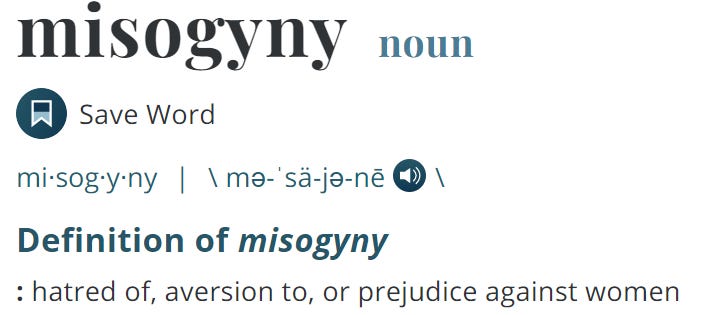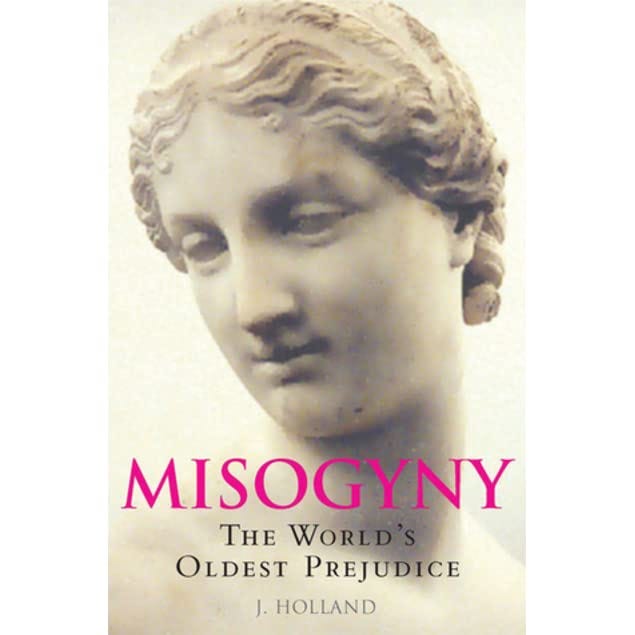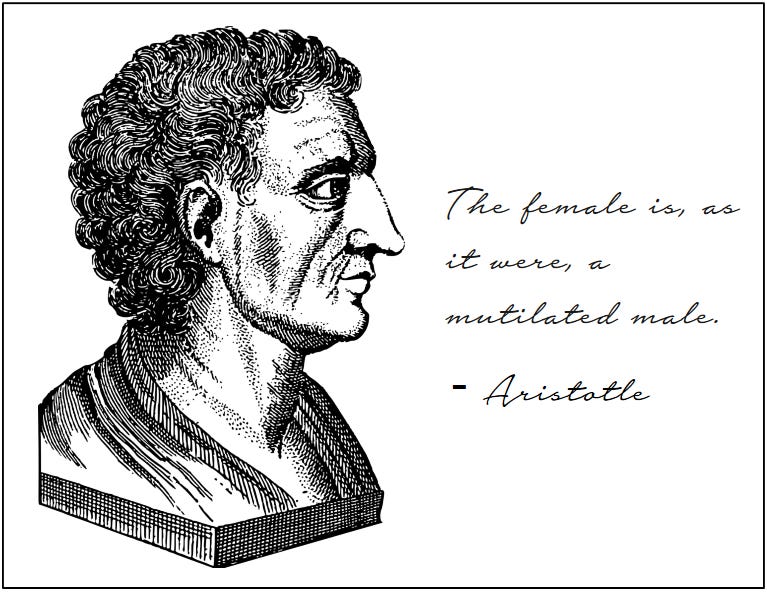Hello, friends, and welcome. Thanks for reading. Today, I’m going to take a bit of a detour from American politics for a moment, and discuss another equally heavy topic that I am interested in—misogyny. (I’ll have to work on exploring some more uplifting topics in the future).
My interest in misogyny is rooted in the simple fact that I, as a woman myself, am subject to and a product of its long history. In 2013, I was interested in learning more about the history of misogyny, and through a simple Google search I discovered the book Misogyny: The World’s Oldest Prejudice, by Jack Holland.
I posted a review of the book on my Goodreads account in July of 2013. This book was packed full of so many interesting facts that my goal with this particular book review was, more than anything, to record some of the most interesting points I didn’t want to forget. What follows here is a revised version of that book review.
This book really is a brief history of misogyny (and in fact, an updated edition was later published with the new title, A Brief History of Misogyny). Although the author could have gone into so much more detail, there are still so many examples of misogyny packed into this little book it is a bit overwhelming.
The Ancient Greeks
Holland begins his history with the ancient Greeks. He doesn’t just arbitrarily choose this period to begin with. He affirmatively argues that misogyny truly began with the ancient Greeks. I am skeptical of this assertion and its western bias. However, given that this can only be a brief history and because western history is most relevant to my own heritage, I still found the book worthwhile to read.
Let me point out a few things that struck me about the book. For one, and this was probably naïve, but I was shocked to learn of the severe misogyny of the long extolled Greek philosophers, especially Aristotle. (Oh, sweet 2013 me—I would not be so surprised had I first read this in 2021. I have become far more cynical in my expectations of humans in the intervening years).
For example, Aristotle taught that semen carried the human soul, and women played a merely nutritive role in the human creation process. Furthermore, “the full potential of the child is reached only if it is born male; if the ‘cold constitution’ of the female predominates, through an excess of menstrual fluid in the womb, then the child will fail to reach its full human potential and the result is female. ‘For the female is, as it were, a mutilated male,’ Aristotle concludes.” This irritates me because he just pulls this conclusion out of thin air, and yet it goes on to dominate thought for nearly 2,000 years, greatly influencing Christianity and social behaviors along the way.
Christianity
The next thing that struck me was learning about misogyny in the context of the history of Christianity. It all begins with a train of thought perpetuated by Saint Paul, early Christian writer Tertullian, and Saint Augustine (all of which were likely influenced by early classical thinkers mentioned previously). These men advanced theories centered on rejecting the body—its needs and desires—as inherently evil and a hindrance to greater knowledge of God and to salvation (salvation itself being one of Christianity’s newly created ideas).
Marriage was therefore seen as a necessary evil to reign-in bodily (i.e. sexual) desires, but “sanctity was identified more and more with virginity.” These views worked themselves especially harshly on women. Holland explained that “woman was bound to suffer because of our nasty habit of blaming that which we desire for making us desire it.” (And of course it didn’t help that it was a woman that caused the original downfall of man in the first place, according to the Book of Genesis). One example of the tangible effect of this thinking is the norm that women must dress modestly to avoid tempting men who can’t help themselves. (Sometimes it’s hard to see much difference between the first century and the twenty-first.)
This brings me to the discussion I found most interesting, regarding the exaltation of Mary by Christians and ultimately the Catholic church. It was fascinating to me to see how certain ideas snowballed and built upon themselves over decades and centuries to result in our ideas about Mary as the perfect model of woman. Here is an extremely summarized version of that history and transformation.
After Jesus died, people were left to sit and think about this new concept of Christianity and what it all meant, and men inevitably began coming up with explanations for everything. First, and only after many arguments, it was decided by men that Jesus was both man and God. (Jesus never said this outright). This naturally led to the thought that if Jesus is God, Mary has to be the mother of God. The Gospels do mention Mary being a virgin at Jesus’ birth, but because of the nasty feelings about sex going around, as I mentioned above, men decided it seemed unfitting that the mother of God should have ever defiled herself in such a way. Therefore it was determined by men that Mary was always a virgin—both before and after Jesus’ birth. Next, men decided it was unsuitable that Mary should have suffered a fate as human and base as death, so they decided that she must have ascended into heaven, body and soul, instead of dying. Even later, people decided it would be unbefitting of the mother of God to have been born with original sin like the rest of us beasts, so it was decided by men that Mary was the only human being other than Jesus to have been born without original sin. This incident was dubbed the Immaculate Conception.
It took hundreds of years after Jesus’ death to come to all of these conclusions—most of which have no basis in Jesus’ teachings or the Bible generally. In fact, Holland calls Jesus’ actual views on women “revolutionary,” and he argues that, in many ways, the status of women improved with Christianity. It was quite eye opening for me to think about how these pieces of religious dogma were merely points of argument hashed out by men on the basis of their limited and biased human logic, and not on any verifiable facts or even so-called revelation.
In the end, though, the ever expanding glorification of Mary created quite a problem for real women. How is anyone supposed to live up to that standard of perfection? It is impossible, and real women continued to be seen as evil, sexual impediments to Godly salvation. The best a woman could do was to remain a virgin, thus denying women one important aspect of their being—their sexuality. Our obsession with virginity permeates even to the present day.
Final Thoughts
There is much more history that Holland goes over in the book, but I’ll be skipping far ahead to the end of the book, to highlight some of his conclusions. He quotes psychologist and author Steven Pinker in saying that there is “no incompatibility between the principles of feminism and the possibility that men and women are not psychologically identical.” Holland explores the fact that trying to argue that men and women are exactly the same, which many feminists have done in the past, can be just as harmful to women and is really just another form of misogyny in that it denies women their unique traits.
The quote from Pinker continues to say that “equality is not the empirical claim that all groups of human beings are interchangeable; it is the moral principle that individuals should not be judged or constrained by the average properties of their group.” For example, just because women, as a whole, are not as physically strong as men does not mean that qualified women should be denied a place in the military. I would add that this maxim should also apply to discourage the reliance on inaccurate “average properties,” such as the blatantly erroneous, yet historically popular, idea that women are less intelligent than men.
I love this conclusion, and find it so relevant today when I hear conservatives complain that liberals won’t rest until everyone is the same. I will digress briefly here to share the very recent example of Salt Lake County Council member, David Alvord, going on a Facebook rant complaining, among other things, that “the left won’t be happy until we each have light brown skin, exactly alike . . . until there are no males, no females, and we each have the same muscle mass, brains, talents, and energy.” He paints liberals wrong and then demonizes us for his inaccurate portrayal.
Back to the book—Holland argues, therefore, we shouldn’t denigrate things that are considered traditionally female. “The solution is not to reject beauty [referring to the fact that femininity is often associated with beauty], but to reject misogyny.” In other words, it is not incompatible for women to be feminists while still pursuing beauty and other traditionally “feminine” interests. Rather, we simply should not judge or constrain women based these so-called traditional or typical features of femininity.
One last conclusion that I liked was Holland’s argument that “women’s right to choose is not only central to their own integrity, but to the very roots of what makes us human and distinguishes us from other primates.” Think of how much better women’s lives are when they are allowed to choose their partner, to control when they have sex (the right to say no), to control their own property, and to vote.
My final comment is that one thing I found lacking with the book was an explanation of why there is misogyny in the first place. This book is really just a collection of examples. Perhaps it is too difficult to really get at the root of why or how this began, and that still baffles me. I know humans are always suspicious of the “other”—such as other races, religions, nationalities, etc. But with women being half of the world’s population, why is gender discrimination historically so one-sided? Is it simply because men are physically more dominant and could assert their will early on? I wish I understood.
What are your thoughts? Did any of this information about the history of misogyny surprise you?
Like what you’ve read? Please subscribe to get this type of content delivered to your inbox once a week. I appreciate you more than you know!






Holland explained that “woman was bound to suffer because of our nasty habit of blaming that which we desire for making us desire it.” This is the exact garbage excuse the police gave publicly for why the racist incel murdered 8 people (mostly women of Asian descent) in Georgia this week. It also leads to excusing the rape culture that continues to exist.
Great blog post Rachel. I’m looking forward to reading your insights on other important topics.